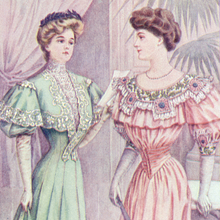Princess line


Princess line or princess dress describes a woman's fitted dress or other garment cut in long panels without a horizontal join or separation at the waist.[2][3] Instead of relying on darts to shape the garment, the fit is achieved with long seams (princess seams) and shaped pattern pieces.[4] A rarely used alternative name for the princess line was French-dart-line dress.[5][6]
History
[edit]19th century
[edit]The princess line is popularly associated with Charles Frederick Worth who first introduced it in the early 1870s.[2][7] It was named in honour of the famously elegant Princess Alexandra.[7][8] By the late 1870s and early 1880s the princess dress was a popular style. It is considered one of the first "bodycon" (body-conscious) fashions due to its extremely closely fitted design, presenting the figure in a natural (or at least, corseted) form undistorted by either crinoline or bustle.[8] Princess-line polonaises were worn over long underskirts.[9] The princess line was also popular for young girls who wore it with a sash or, if slightly older, over a longer underskirt.[10]
20th century
[edit]The princess line was a staple of dress design and construction throughout the century. In 1951 the couturier Christian Dior presented a princess-line based fashion collection which is sometimes called the "Princess Line", although its official name was Ligne Longue or "Long Line".[11]
21st century
[edit]The princess line remains a popular style for wedding dresses and a design staple for both day and evening dresses.[2][4] More recently, the design principle has been applied to men's garments, which generally do not have waist seams.[12]
See also
[edit]References
[edit]- ^ "Princess dress, 1878-1880, jacquard woven silk and ruched silk trimmed with machine made lace". V&A Search the Collections. Victoria and Albert Museum. Retrieved 31 July 2014.
- ^ a b c Delamore, Philip (2005). The wedding dress : a sourcebook. London: Pavilion Books. p. 34. ISBN 9781862057029.
- ^ Lewandowski, Elizabeth J. (2011). The complete costume dictionary. Lanham, Md.: Scarecrow Press, Inc. p. 238. ISBN 9780810840041.
- ^ a b Camp, Carole Ann (2011). Teach yourself visually fashion sewing. Hoboken, N.J.: Wiley Pub. p. 230. ISBN 9780470881316.
- ^ Farmer, Bonnita M.; Gotwals, Lois M. (1982). Concepts of fit : an individualized approach to pattern design. New York: Macmillan. p. 199. ISBN 9780023362606.
- ^ Shelden, Martha Gene (1974). Design through draping. USA: Burgess Pub. Co. p. 35. ISBN 9780808719069.
- ^ a b Reeder, Jan Glier (2010). High style : masterworks from the Brooklyn Museum Costume Collection at the Metropolitan Museum of Art. New York: Metropolitan Museum of Art. p. 41. ISBN 9781588393623.
- ^ a b Fukai, Akiko (2002). Fashion : the collection of the Kyoto Costume Institute : a history from the 18th to the 20th century. Köln [etc.]: Taschen. p. 246. ISBN 9783822812068.
- ^ Stamper, Anita; Condra, Jill (2010). Clothing through American History the Civil War through the Gilded Age, 1861-1899. Santa Barbara: ABC-CLIO. p. 271. ISBN 9780313084584.
- ^ Ashelford, Jane (2009). The Art of Dress Clothes and Society, 1500-1914 ([New ed.?] ed.). London: Gardners Books. p. 283. ISBN 9781905400799.
- ^ Marly, Diana de (1990). Christian Dior. London: B.T. Batsford. p. 45. ISBN 9780713464535.
For the autumn 1951 Dior announced his Long Line, [...] The main cut for dresses was the princess line, Worth's invention to avoid waistlines...
- ^ Kim, Myoung; Kim, Injoo (2014). Patternmaking for menswear : classic to contemporary. New York: Fairchild Books & Visuals. p. 197. ISBN 9781609019440.
